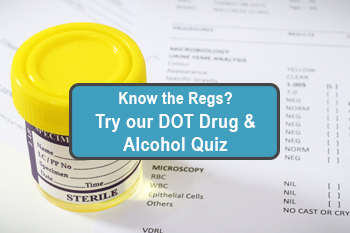DOT Testing | What to Know Before You Test
posted in Alerts, Blog, Uncategorized by Brian Gray
What to Know Before You Test
Article By CleanFleet
DOT drug testing can be a mystery to drivers. Often confusion can take place when answering questions at collection sites about why they are being tested, and language barriers further the misunderstanding. Most small companies utilize Consortium/Third Party Administrators (C/TPA’s) to manage drug and alcohol programs and testing rates are usually met, but little is done to inform individuals why he or she has to take a test. If the driver is at a collection site for a test and not familiar with the regulations it can result in time lost due to mis-handled paperwork, unnecessary phone calls, or a collection site simply refusing to perform the test due to lack of information.
As a C/TPA we are finding great long-term benefit to spending a little time educating our members in the basics of DOT drug and alcohol testing. While we understand that it would not behoove most drivers to become experts, we do recognize that a solid foundational understanding helps to improve the driver’s experience with both the collection site and the program as a whole.
6 tests, and 6 only
The DOT, under Part 40 and Part 382, only allows 6 types of tests, and each one has specific circumstances that must be met in order to qualify. The most common answer we receive when asking an uninformed driver what kind of test they need is “Just a normal drug test.” Unfortunately, because of the strict regulation of testing there is no such thing as a “normal” or “regular” drug test. All drug tests are tested for 5 substances (cocaine, Marijuana, PCP, opiates, and amphetamines.), but the reason for the test is specifically dictated by the regulations. The 6 tests are Pre-Employment, Random, Post-Accident, Return to Duty, Follow-up, and Reasonable Suspicion.
At the Collection Site
To ensure efficient testing and processing it is important to communicate with the collection site. Be sure that they have information for the correct Lab, MRO, and Donor. If the correct information is present from the start all of the paperwork and billing will go smoothly.
Pre-Employment
A pre-employment test is by far the most common test done because every driver must have a negative test to start work. Additionally, the result of that test must also be kept in the Driver File that the company maintains for each of its drivers. To ensure that the driver knows what should happen at the collection site it is good to inform the driver of all the information that needs to be on the testing form, including the full, official name of your company and contact information should the collection site have any questions.
The DOT does provide a pre-employment test exception (49 CFR Part 382.301) for drivers who are changing employers. If the driver has been part of a compliant testing program within 30 days of starting work with you, you may be eligible for a pre-employment waiver. As long as that driver has either 1) been tested within the last 6 months, or 2) been available for random testing for the last 12 months, you don’t need a pre-employment test. You must, however, obtain information from the driver’s previous program provider stating that the driver was a member and that he had no violations within the previous 6 months.
Random
Drivers are selected for random testing by the program administrator using a scientifically valid method. Most administrators will use a computer program designed to give a truly random selection. Because there is no order to a random selection, perceived patterns can seem to ebb and flow. For instance, it is entirely possible to have a driver selected during each draw for a year, and another driver to never be selected. It is also possible to be selected once or twice a year. No “patterns” can be indicators that the selection is not truly random because all “patterns” are possible.
Regulations state that a driver must report immediately to the collection site after they are notified that they have been selected. Many companies appoint an individual to manage notifying the specific drivers in a manner that is beneficial to the business. For example, if the driver has just returned to the terminal with the last load of the day, the Employer Representative will tell them that they must go test. Additionally, drivers can be selected to be tested for Drugs, Alcohol, or both depending on the selection process of your C/TPA.
Post-Accident
Post-Accident testing is done under the authority of the DOT when the accident meets certain criteria. If a human life is lost in the accident, regardless of the fault, the driver must be tested for alcohol within 2 hours of the accident and tested for drugs within 32 hours of the accident. If there was no human life lost, then in order to be tested the driver must have received a citation AND have caused disabling damage to a vehicle or caused a person to receive medical care away from the scene.
Return to Duty
When a driver is found in violation of Drug and Alcohol policy rules (positive test, refusal to test, etc…), he must be evaluated by a Substance Abuse Professional (SAP). The SAP will prescribe treatment that must be completed prior to the driver returning to work. Before the Driver gets back to work he must pass a Return to Duty test. The Return to Duty test can be for drugs, alcohol, or both depending on the recommendation of the SAP. Collection is directly observed, which means that the collector must watch the urine leaving the body and entering the collection container. This can be awkward at first, but unfortunately the usual nature of habitual drug users necessitates extra measures to prevent cheating. The Return to Duty test does not need to be “random” from the driver’s perspective.
Follow-up
After the Driver passes his Return to Duty Test he will be prescribed a Follow-up schedule from his SAP. At a minimum 6 tests must be performed over the first 12 months. The SAP has sole discretion on the frequency and duration, up to 5 years of testing. Who pays for the testing can be negotiated between the driver and employer.
The driver will be made aware of the duration that they are to be tested, but the actual testing event should be random from his perspective. No discernible patterns should be used (i.e. every other Monday, on the 15th of every months, etc…) to prevent the donor from attempting to falsify or cheat on his test. Similar to the Return to Duty testing, the Follow-up tests are always observed.
Reasonable Suspicion
When a driver exhibits a change in characteristics that indicate a potential drug or alcohol policy violation, it is up to a trained supervisor to direct a Reasonable Suspicion test to determine if drug or alcohol misuse is the cause of the changes. It is very important that the trained supervisor document the reason for the testing prior to the test being performed. Typical Reasonable Suspicion tests are not observed unless the driver attempts to tamper with the process.
Every person who supervises drivers must be trained in Reasonable Suspicion drug testing. The training equips the supervisor to recognize contemporaneous, articulable changes that indicate drug and alcohol use. The training time is 60 minutes on drugs and 60 minutes on alcohol. After the training, the supervisor does not need to repeat it, and it is transferrable if the supervisor changes employers.
Conclusion
It is possible to have testing under your own company policy that differs from these testing types, but we hope that this helps you as you navigate the world of DOT regulated drug testing. Testing can be tricky if you are not aware of the purpose for each drug test. Knowing the how’s and whys help to save time and money. Please don’t hesitate to call us at CleanFleet if you need a Consortium or have questions about the regulations!







